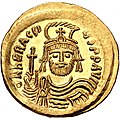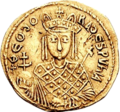Top Qs
Timeline
Chat
Perspective
List of Byzantine emperors of Armenian origin
From Wikipedia, the free encyclopedia
Remove ads
According to medieval and modern sources, a number of Byzantine emperors were allegedly Armenian or of partially Armenian heritage. The following list includes the Byzantine emperors to whom sources attribute Armenian origin. Speculation of Armenian ancestry in emperors remains a wide topic of debate.



Remove ads
History and criticism
Summarize
Perspective
In 1891 John Buchan Telfer reported to the Royal Society of Arts several Byzantine emperors of Armenian origin, including Maurice and John Tzimiskes.[8]
The first work on Byzantine emperors of Armenian origin, Armenian Emperors of Byzantium (Armenian: Հայ կայսերք Բիւզանդիոնի), was authored by Fr. Garabed Der-Sahagian and published in 1905 by the Mekhitarist congregation of San Lazzaro degli Armeni in Venice.[9] Anthony Kaldellis suggested that Der-Sahagian extended "western European modes of racial and nationalist historiography to the history of medieval Armenia." Kaldellis believes that it was Nicholas Adontz who "made the search for Armenians in Byzantium into a more scholarly and less romantic nationalist process." However, he is critical of Adontz as he saw "Armenians everywhere and injected them into as many important events as he could." According to Kaldellis it was later endorsed by Peter Charanis and Alexander Kazhdan and "has spread widely in the field of Byzantine Studies."[10] Kazhdan's book Armenians in the Ruling Class of the Byzantine Empire in the 11th-12th Centuries was published by the Armenian Academy of Sciences in Russian in 1975.[11]
Charanis suggested that "every emperor who sat on the Byzantine throne from the accession of Basil I to the death of Basil II (867—1025) was of Armenian or partially Armenian origin."[12] However, he noted that "in Byzantium the ethnic origins of a person was of not significance, provided he integrated himself into its cultural life."[13] Speros Vryonis listed the Heracleian and Macedonian dynasties as being of Armenian ancestry, along with individual emperors like Leo V, Romanus I, and John Tzimisces.[14]
Robert H. Hewsen counted "no fewer than sixteen emperors and eleven empresses" of Byzantium of Armenian origin and suggested that Armenians ruled "for almost a third of [the empire's] history." He conceded, however, that "[m]ost of these Armenians, of course, were thoroughly hellenized, membership in the Greek Church being the sine qua non for advancement in the Byzantine world."[15]
Anthony Kaldellis is highly critical of what he calls the "Armenian fallacy" in Byzantine studies to which he dedicated a separate chapter (Armenian fallacy) and a sub-chapter specifically about emperors ('Armenian' emperors) in his 2019 book Romanland: Ethnicity and Empire in Byzantium, published by Harvard University Press.[16] He wrote:[17]
The consensual mass hallucination that is the Armenian fallacy has populated Byzantine history with a series of alleged “Armenian” emperors.
Even earlier, in 2008, Kaldellis wrote in a publication for Oxford University Press:[18]
Here our scholarship creates confusion by calling these people, in obedience to the needs of modern nationalism, “Armenians,” “Bulgarians,” “Arabs,” and so on. In the vast majority of cases, however, what they should be called are Romans of Armenian descent (or Slavic, or whatever it might be), and in most cases they should not be called that at all without good reason. There is every indication that they or their immediate descendents were fully assimilated to the customs, language, religion, and social consensus that maintained—and, in fact, constituted—the (Byzantine) Roman nation. It makes as much sense to call the emperors Herakleios or Basileios I “Armenians” as it does to call president Bill Clinton an “Englishman” or Barack Obama a “Kenyan”—even less so, in fact, as the former ethnic attributions are mostly conjectural on our part. There is no evidence that these emperors spoke their supposed “ancestral languages” or knew much about the customs of their supposed ancestor. Yet since Roman national claims have never been taken seriously, Byzantinists have filled the gap with modern ones. It is also no coincidence that modern historians will label a Byzantine as an “Armenian” (or the like) overwhelmingly in cases when a modern nation corresponding to that label still exists and presses its ethnic claims to the past. Peoples who have since lost their lobbying power—for example, Goths, Pechenegs, and many others—have curiously lost their right to similarly colonize the Byzantine “assimilated” subject. This discrepancy reveals the modern dynamic behind this ethnicizing discourse.
Kaldellis' criticisms of the "Armenian fallacy" have been subsequently endorsed by historians such as Johannes Preiser-Kapeller,[19] Alexander Beihammer,[20] Marek Klatý,[21] and C.J. Meynell,[22] among others.[23] Toby Bromige wrote that Kaldellis "may at times seem dismissive of the depth and influence that Armenians had within Byzantium, especially the strength of ancestral descent in certain individuals, but he correctly identifies a lack of relevant historical investigation and precision."[24]
Remove ads
List
Summarize
Perspective
Remove ads
See also
References
Bibliography
Wikiwand - on
Seamless Wikipedia browsing. On steroids.
Remove ads














